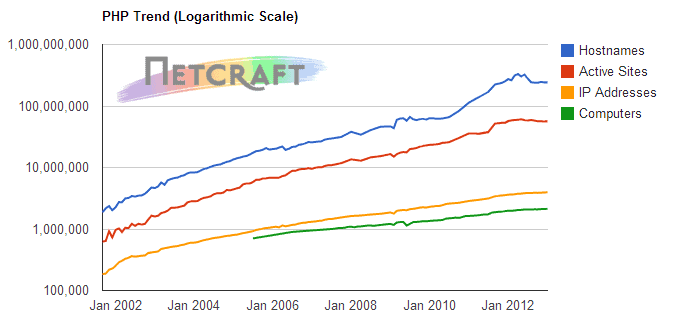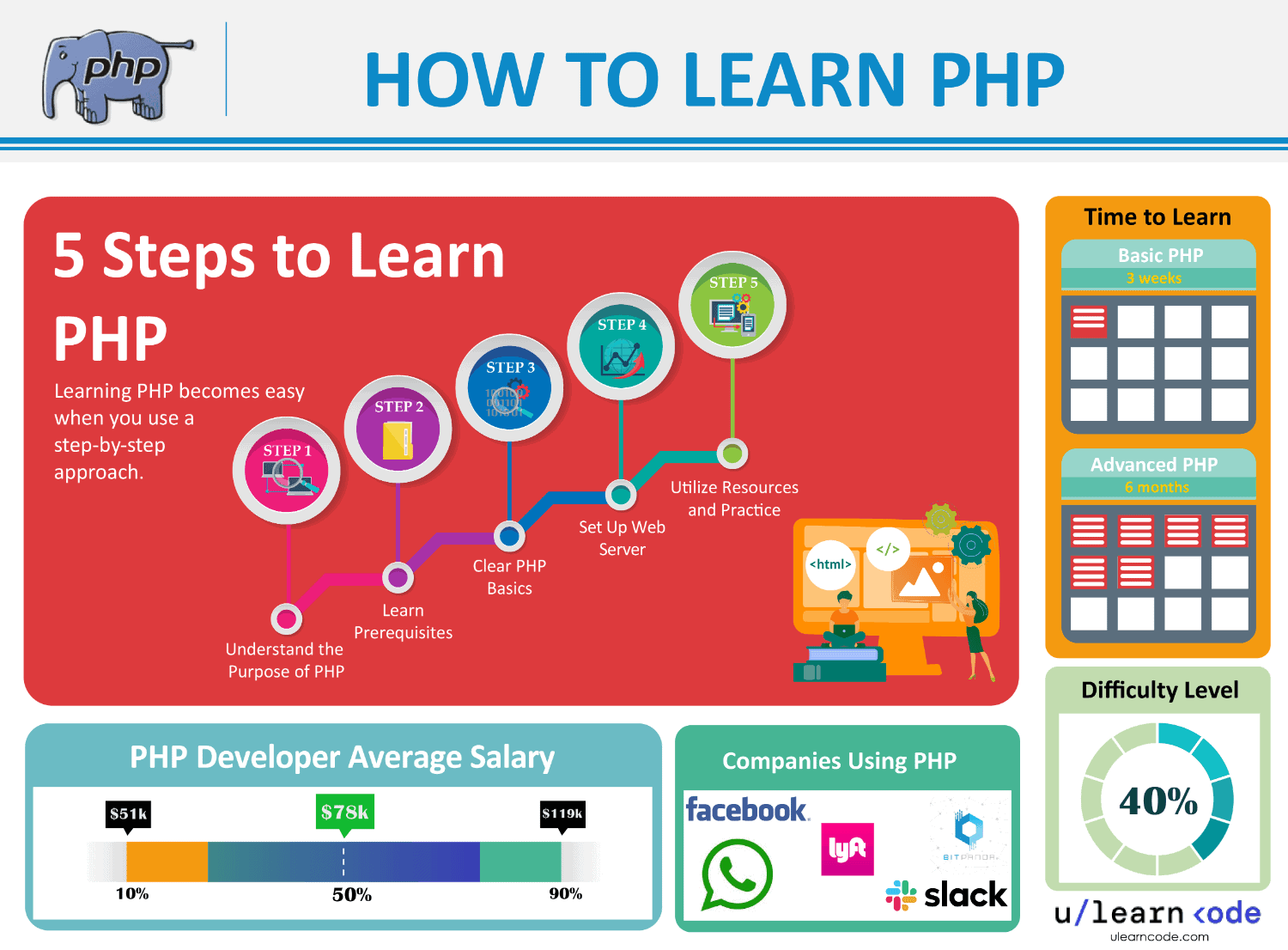Contents
PHP is the most popular server-side programming language and is currently being used in 79.1% of websites. According to NetCraft, this percentage includes over 244 million sites, all of which use PHP as their core language, whether it’s in the form of CMS or source code.

The above logarithmic scale shows the exponential growth of PHP over the course of 10 years. The number of hostnames and sites using it is still on a rise and this growth is expected to continue as the language keeps improving their infrastructure by introducing newer versions.
PHP has widespread usage in web development, content management systems, GUI applications and eCommerce applications. It’s a more than worthwhile language to learn as the world’s biggest CMS, WordPress, is also based upon PHP.
Let’s dig a bit deeper and see how one can learn PHP without facing many hurdles and how difficult it really is to learn.
How Difficult Is PHP to Learn?
If you have a programming or specifically web development background then PHP will be relatively easier to learn. However, if you are a newbie programmer, then the language syntax and concepts might confuse you.
Thankfully, it shares some similarities with JavaScript. For example, the syntax for looping constructs is nearly identical. Unlike C and C++, there are no pointers to be afraid of. Hence, PHP is easily learnable if you are already familiar with some programming languages.
If your goal is to become a full-stack web developer, then PHP should not be the first language on your hit list. Instead, you should learn web development languages in the following order:
- First: HTML
- Second: CSS
- Third: JavaScript
- Fourth: PHP
Once you have a strong grip on the first three languages, PHP is going to be a much easier option as you will be able to form a connection between all four languages with their specific purposes.
How Long Does It Take to Learn PHP?
It generally takes somewhere around 550 – 750 hours to learn this language. In this time period, you’d be able to become a junior PHP developer. However, if you are willing to spend 15 hours per week working on it, then you can have a strong grip on the language in a single year.
This time period is not definite as things are also dependent on your prior experience and skill with programming. If you already possess C or C++ skills, you’re unlikely to have any problems.
However, if you are just a person with basic computer knowledge, it is highly recommended to first learn the basics of overall programming and then move on to PHP for development purposes.
If you are a fast learner, then one month is sufficient to pick up the basic concepts. Once you grab those basic language concepts, then you can explore frameworks to develop simple applications. Still, you will need extra time to learn PHP frameworks as well.
5-Step Way to Learn PHP

Before we move ahead with our roadmap to learn PHP, you must be aware that it is not enough to code the complete back-end of a website. You also need MySQL knowledge to efficiently develop the back-end system of a site. Hence, PHP and MySQL go hand-in-hand.
#1: Understand the Purpose of PHP
Learning a language without knowing its actual purpose is surely a waste of time. Firstly, PHP is a scripting language which is largely used on the server-side of a website. The scripts written in it are then converted to HTML to show the front-end results.
PHP helps you create interactive websites where users can save and access a variety of information using a fully-functional webpage.
The user information is normally saved in a database which is handled by MySQL. Hence, you need to use both these languages together if you are creating any games, online forums or stores.
#2: Learn Prerequisites
The majority of people learn this language for web development purposes. Hence, only learning PHP is not enough in most cases. Your PHP code is translated to HTML and CSS and that’s why you should know the basic tags and elements of these languages as well.
JavaScript is another prerequisite that deals with interactive front-end. Learning these programming languages will give you a slight edge over other developers.
#3: Clear PHP Basics
This is a major introductory phase where you have to grasp each basic concept of PHP with all your efforts. All these concepts and statements are somehow correlated to serve a purpose. Therefore, you cannot skip any of them for the sake of fast learning.
So where to start your learning journey? Any of these basic PHP courses will thoroughly guide you through each concept while clearing all of your language-related confusions. If you prefer free sources, then here are a few options to explore:
- PHP Tutorials – Dani Krossing
- PHP Programming Language Tutorial – freeCodeCamp.org
- PHP Programming Tutorial for Beginners – Edureka
#4: Setup Web Server
You can either buy or set up a free web server on your localhost. A web server is necessary to test your PHP code and see some results. XAMPP is one of the most popular development environments that you can easily set up on your computer.
In case you do not know how to set up XAMPP, check out the following tutorial:
How to Install XAMPP Server – Edureka
#5: Utilize Resources and Practice
There are a number of free and paid sources that you can utilise after learning the basic concepts, including books, tutorials, courses and forums. If you want exposure to the PHP community, then you can utilize the following forums:
Seek guidance from expert developers on these forums and use the right frameworks and tools to reach your end development goals. Just make sure you practice each concept by solving real problems using your code.
Wrapping It Up
PHP is continuously rising in popularity because many CMS systems such as WordPress have been utilizing it for years. Hence, PHP is a worthy option for developers who want to gain expertise on the server-side of a website.